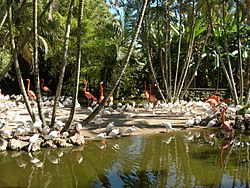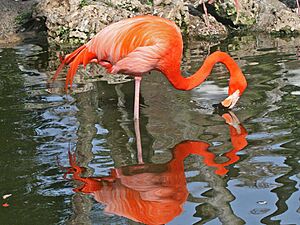Flamingo Gardens facts for kids
Quick facts for kids Flamingo Gardens |
|
|---|---|

The main attraction of Flamingo Gardens
|
|
| Lua error in Module:Location_map at line 420: attempt to index field 'wikibase' (a nil value). | |
| Location | 3750 South Flamingo Road, Davie, Broward County, Florida, United States |
| Area | 60-acre (24 ha) |
| Created | January 2, 1927 |
| Status | Open year-round |
Flamingo Gardens is an amazing 60-acre (24 ha) botanical garden and wildlife sanctuary in Florida. It's located west of Fort Lauderdale and north of Miami. This special place is open to everyone for a small fee. You can explore beautiful plants and meet many different animals here!
Contents
A Look Back in Time
Flamingo Gardens started a long time ago, in 1927. A couple named Floyd and Jane Wray built a weekend home here. They also planted a citrus grove and a special garden. This area was right next to the the Everglades.
The Wrays loved collecting rare and unusual tropical plants. They gathered fruit trees and other plants from all over the world. Today, their old home is a museum. It shows what a country home looked like in the early 1930s. You can take guided tours to learn more about it.
A special group called the Floyd L. Wray Memorial Foundation helps keep the gardens safe. They make sure future generations can enjoy this beautiful property and its plants.
Exploring the Collections
Flamingo Gardens is home to thousands of different plants and many cool animals. It's like a giant outdoor classroom!
Wonderful World of Plants
The gardens have over 3,000 kinds of tropical and subtropical plants. You can see huge, 200-year-old Southern live oaks. There are also more than 300 types of palm trees!
A fun tram ride takes you through different areas. You'll see a tropical rainforest, a native hammock, and wetlands. These areas are full of amazing flora (plants).
Special Plant Collections
Flamingo Gardens has many nationally recognized plant collections. These include colorful heliconias, gingers, and calatheas. You'll also find bright bromeliads and beautiful flowering trees. There are also palms, crotons, aroids, succulents, orchids, ferns, and cycads. Don't miss the mango orchard and the pollinator's garden, which helps bees and butterflies!
Giant Champion Trees
The garden has a jungle-like arboretum. This is a place where many different trees grow. It features 23 Champion trees. These are some of the largest trees of their kind in the state or even the country! One huge tree is an Enterolobium cyclocarpum, also known as an ear tree.
This arboretum has one of the biggest collections of non-native champion trees in the area. Some examples include the pink trumpet tree, yellow poinciana, and dynamite tree. You can also see the Indian jujube, bread nut tree, wampi, and white sapote. There's even a Xeriscape Garden. This garden shows how to grow plants that need very little water.
Amazing Animals to See

Flamingo Gardens is a safe home for many animals. You can see bright American flamingos and a American black bear. There are also North American river otters, American alligators, and bobcats. Keep an eye out for Florida panthers, turtles, and colorful peacocks. You might also spot fish crows, bald eagles, owls, and other birds of prey.
The sanctuary also cares for exotic animals. These include African spurred tortoises, keel-billed toucans, parrots, and macaws.
The Everglades Aviary
The huge Everglades aviary is a special place. It's about 25,000 square feet (2,300 square meters)! This aviary is one of the largest bird and animal collections in the United States.
Inside, you'll find many different bird species. These include American white pelicans, brown pelicans, and wood storks. You can also see American white ibises, roseate spoonbills, and great blue herons. Other birds include black-crowned night herons, fulvous whistling ducks, anhinga, double-crested cormorants, and laughing gulls.
The aviary shows four different natural environments found in Florida. These are the coastal prairie, mangrove swamp, sub-tropical hardwood hammock, and sawgrass marsh. It's a great way to see how these birds live in the wild!
See also

